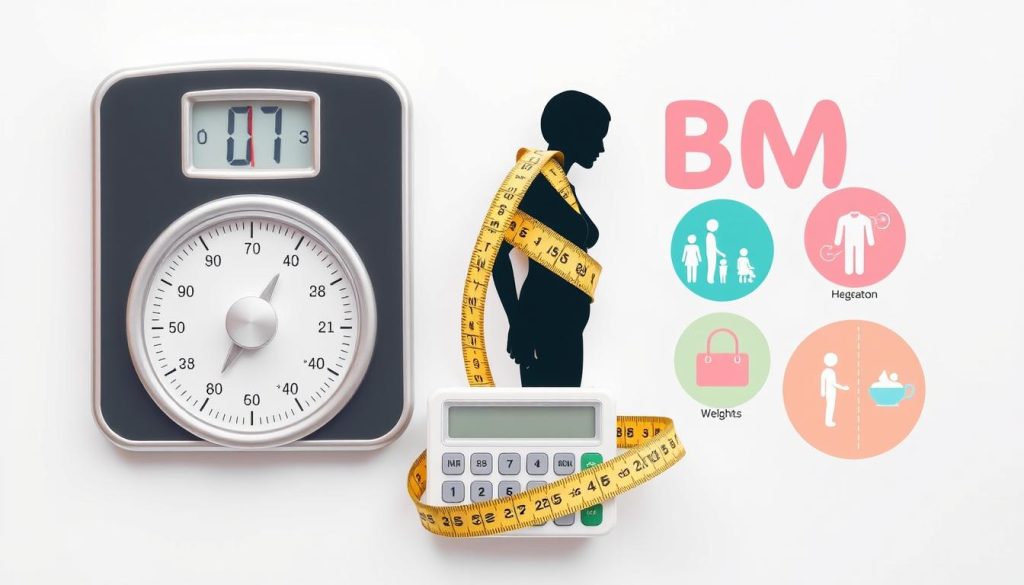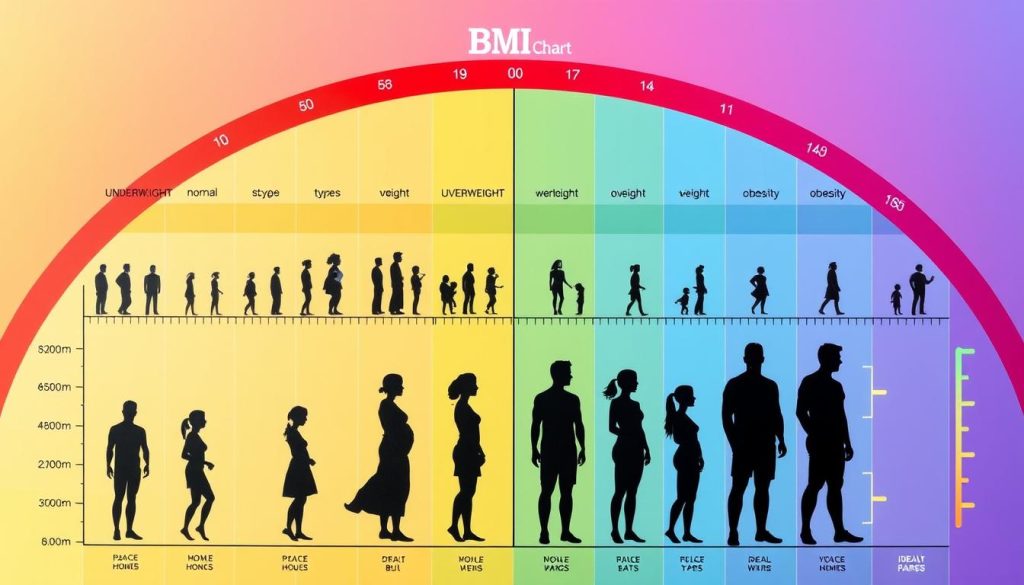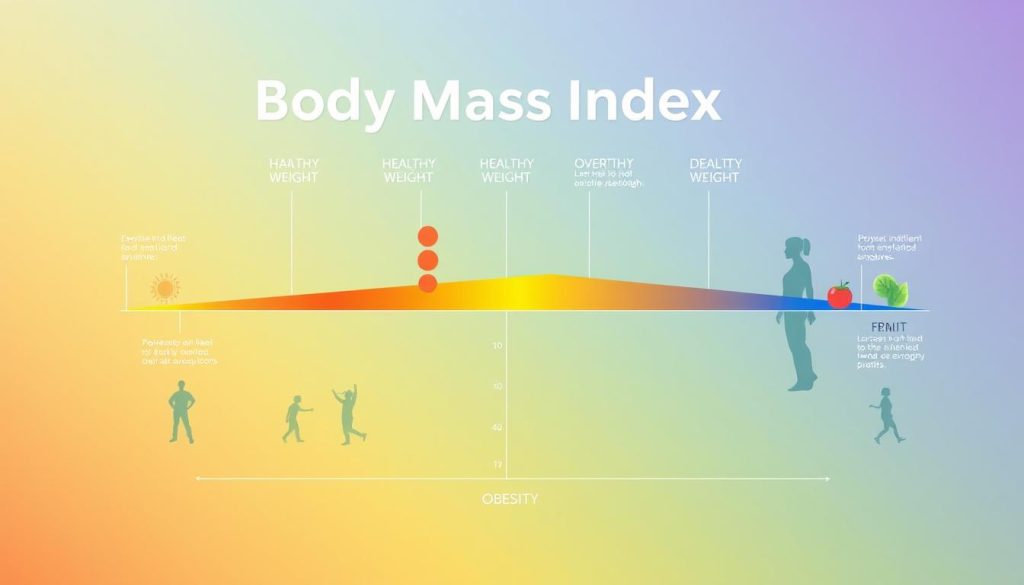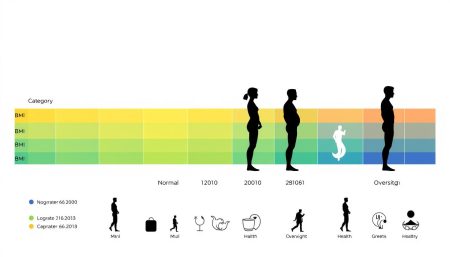Starting on the journey to well-being, many wonder: what is a good body mass index? This question mixes science and the art of a healthy life. Imagine someone standing, confused by all the opinions on weight.
Then, they find the Body Mass Index—BMI. It lights up the confusion, showing a clear path through myths and half-truths.
Knowing your BMI is like having a compass in the health wilderness. It guides you to a healthy weight range and away from unhealthy weights. Striving for an ideal BMI helps shape diet and fitness plans. It connects abstract health ideas to real-life changes.
So, aiming for a ‘good’ BMI is more than just a number. It’s about a complete view of health.
Starting this journey, it’s key to see BMI as more than just numbers. It’s about understanding your body and its needs. Let’s explore together, finding what makes a good body mass index—a key to the best health.
Key Takeaways
- Grasp the significance of determining what constitutes a good body mass index for personal health.
- Recognize BMI as a tool that helps navigate towards a healthy weight range.
- Identify ideal BMI as critical for customizing diet and exercise routines.
- Employ BMI knowledge to transcend basic health metrics and embrace a comprehensive wellness outlook.
- Consider BMI as a starting point, not the sole indicator, for overall health and well-being.
Understanding Body Mass Index (BMI)
Body Mass Index (BMI) is key in checking health and managing weight. It shows important info about body composition. This part explains what BMI is, how to calculate it, and what different BMI levels mean.
What Is BMI?
BMI is a number that checks if your weight is healthy for your height. It’s a simple way to see if you’re at a good weight, but it doesn’t measure body fat directly.
How Is BMI Calculated?
To find your BMI, divide your weight in kilograms by your height in meters squared. If you use pounds and inches, multiply your weight in pounds by 703, then divide by your height in inches squared.
BMI Categories Explained
The table below shows BMI ranges and their health meanings. It’s key for managing weight and knowing health risks:
| BMI Range (kg/m2) | Category | Health Risk |
|---|---|---|
| Under 18.5 | Underweight | Potential nutritional deficiency and osteoporosis |
| 18.5 – 24.9 | Normal Weight | Lowest health risk |
| 25 – 29.9 | Overweight | Increased risk of cardiovascular disease |
| 30 or above | Obese | High risk of diabetes, heart disease, and cancer |
This helps people know their health status and how to manage their weight better.
Understanding BMI is vital for health management. It’s important to see it as part of a bigger health check, not just a number.
Why Is BMI Important?
Knowing the BMI importance is key to checking your health and wellness. It’s not just a number. It’s a big clue for spotting disease risks and keeping your weight in check.
Health Implications of BMI
The link between Body Mass Index and health is clear. A BMI in the healthy range means you’re less likely to get diseases like high blood pressure, type 2 diabetes, and some cancers. On the other hand, an abnormal BMI can warn of health issues, making it important to manage your weight well.
BMI and Disease Risk
Understanding BMI is vital for spotting disease risks. A high BMI can increase the chance of heart diseases, putting too much pressure on your heart and blood vessels.
To keep track of weight-related health risks, check out this 6-week weight loss plan. It shows how to set achievable goals and the value of getting medical advice.
| BMI Category | Health Risks |
|---|---|
| Underweight | Malnutrition, osteoporosis, immune dysfunction |
| Normal Weight | Lower risk of chronic disease |
| Overweight | Increased risk of CVD, diabetes, joint problems |
| Obesity | High risk of CVD, diabetes, cancer, hypertension |
Seeing how BMI affects health shows why keeping a balanced BMI is crucial for overall health.
How to Calculate Your BMI
Knowing your Body Mass Index (BMI) is key to checking your health. You can use a simple formula or online tools. But, remember to think about your own health details for the best results.
Using a BMI Formula
The basic BMI formula is weight in kilograms divided by height in meters squared. If you use pounds and inches, first multiply your weight by 703. Then divide by your height in inches squared. This method helps quickly figure out your fat percentage and health category.
Online BMI Calculators
Today, there are many online BMI calculators. They quickly give you a BMI based on your weight and height. They also adjust for kids, teens, and different populations, making them more accurate.
Considerations for Accuracy
Online tools and formulas are good starts, but they’re not perfect. Muscle, age, gender, and ethnicity can change your BMI. It’s smart to look at BMI with other health measures like waist-to-hip ratio. This helps get a clearer picture of your health.
The Cleveland Clinic also talks about BMI’s role in health risks. They give more insight into its value and limits.
| Method | Description | Suitability |
|---|---|---|
| Manual Calculation | Uses formula: weight (kg) / [height (m)]^2 | Good for quick checks, not individual-specific |
| Online Calculators | Automated tools for entering personal data to receive BMI | Convenient, with adjustments for demographics |
| Professional Assessment | Includes comprehensive health evaluation beyond BMI | Best for personalized health advice |

In conclusion, using online tools and traditional methods is helpful. But, remember to consider your personal health details. This way, you get a true BMI and understand its health meaning. As we learn more about health, being adaptable is key to our well-being.
Factors That Influence BMI
It’s important to know how different things affect BMI. These factors include our body’s natural changes and our lifestyle. They all play a big role in what our BMI is, showing how complex BMI can be.
Age and BMI
As we get older, our bodies change. We lose muscle and might gain fat, which can make our BMI go up. Even if we don’t gain weight, our BMI can still increase. It’s key to understand these changes to get a correct BMI reading at any age.
Gender Differences
Men and women have different body types, which affects BMI. Men usually have more muscle than women, leading to different BMI numbers. It’s important to know these differences to get an accurate BMI reading.
Muscle Mass vs. Fat Mass
The mix of muscle and fat in our bodies is very important for BMI. Even if someone has a higher BMI, they might actually have less body fat. This shows that BMI isn’t always a perfect measure of health.
| Factor | Impact on BMI | Example |
|---|---|---|
| Age | Increases with age due to reduced muscle mass | Elderly individuals often show higher BMI |
| Gender | Men tend to have higher BMI due to more muscle mass | Average BMI higher in males than in females |
| Muscle vs. Fat | High muscle mass can result in higher BMI but lower body fat | Athletes with high muscle composition |
Limitations of BMI
The Body Mass Index (BMI) is often used to check health. But, it has BMI limitations in showing body composition measures. This article looks at what BMI misses and other ways to measure body fat percentage and health.
What BMI Doesn’t Measure
BMI uses height and weight to calculate body mass. But, it can’t tell the difference between muscle and fat. This mistake can happen to athletes with a lot of muscle.
BMI also doesn’t look at where fat is in the body. This is important for health risks. It doesn’t consider age, sex, or ethnic background, which affect body composition.
Alternate Measurement Methods
To get past BMI limitations, there are better ways to measure body composition measures. Knowing your body fat percentage gives a clearer health picture than BMI. Here are some advanced health assessment methods:
- Dual-Energy X-ray Absorptiometry (DEXA) scans show detailed body composition, including fat, muscle, and bone density.
- Bioelectrical Impedance Analysis (BIA) uses a low-level electrical signal to estimate body composition.
- Hydrostatic Weighing, or underwater weighing, measures body density to find body fat percentage.
These methods are more accurate but can be expensive and hard to access.
| Method | Description | Benefits |
|---|---|---|
| DEXA | Uses low-level X-rays | Precise measurement of body composition and bone density |
| BIA | Electrical signal analysis | Quick and non-invasive |
| Hydrostatic Weighing | Body density estimation in water | Highly accurate body fat measurement |
Knowing the good and bad of BMI and other body composition measures helps understand health better.
Ideal BMI Ranges
Knowing your ideal BMI and staying within a healthy weight range is key for managing your weight. The Body Mass Index (BMI) is a simple way to check if your weight is healthy for your height. It helps guide your health choices and lifestyle.
Healthy BMI Range
The healthy weight range is between a BMI of 18.5 and 24.9. This range is best for most people to stay healthy. It lowers the risk of serious health issues like heart disease, diabetes, and some cancers.
Underweight and Overweight Defined
A BMI under 18.5 is usually underweight, and a BMI from 25 to 29.9 is overweight. Remember, these are general guidelines. Genetic, environmental, and physiological factors can affect what’s best for you.

| BMI | Classification |
|---|---|
| Under 18.5 | Underweight |
| 18.5 – 24.9 | Normal weight |
| 25.0 – 29.9 | Overweight |
| 30.0 and above | Obesity |
Understanding your ideal BMI is important. But, don’t forget about overall health and wellness. Good weight management means more than just a healthy BMI. It’s about being well in body and mind.
Maintaining a Healthy BMI
Keeping a healthy Body Mass Index (BMI) is more than just watching what you eat or how much you exercise. It’s about living a lifestyle that supports your well-being. This means following weight loss tips, getting nutritional guidance, and setting fitness goals that are realistic.
Nutrition Tips
Good nutrition is about eating the right foods in the right amounts. Eating a variety of foods every day helps keep your BMI healthy. Here are some tips:
- Eat a balanced diet with lots of fruits, veggies, lean proteins, and whole grains.
- Try to avoid foods high in calories but low in nutrients, like sugary snacks and drinks.
- Watch your portion sizes to keep calorie intake in check without missing out on nutrients.
Importance of Physical Activity
Staying active is key to a healthy BMI. It helps balance the calories you eat with the energy you burn. Here’s how to match your workouts to your fitness goals:
- Make sure your routine includes cardio, strength training, and flexibility exercises.
- Set goals that are reachable to keep you motivated and track your progress.
- Change up your workouts to keep them interesting and challenging as you get better.
Understanding how diet and exercise work together is important. It helps keep your BMI healthy, improving your health and energy.
| Activity | Frequency | Benefits |
|---|---|---|
| Cardio Exercise | 3-5 times a week | Improves heart health, aids in weight control |
| Strength Training | 2-3 times a week | Increases muscle mass, boosts metabolic rate |
| Stretching/Flexibility | Daily | Enhances mobility, reduces injury risk |
By following these structured diet and exercise plans, you not only keep a healthy BMI. You also improve your overall quality of life.
When to Consult a Healthcare Professional
Knowing when to get professional health advice is key for your wellbeing. This is especially true for weight management and health. It’s important to understand how your Body Mass Index (BMI) affects your health.
Signs You Should Seek Help
Noticeable and sudden weight changes are a sign to see a doctor. If your BMI shows you’re underweight or obese, it’s time to get help. Look out for fatigue, trouble managing your weight, or pain in your joints or back.
How Professionals Can Assist
Healthcare experts offer vital weight management assistance. They look at your health history, lifestyle, and needs. They create plans to help you manage your BMI and improve your health.
| Professional Assistance | Benefits |
|---|---|
| Dietary Planning | Custom meal plans to meet nutritional needs and manage BMI effectively. |
| Regular Health Monitoring | Tracks progress and adjusts plans as necessary, ensuring optimal health. |
| Exercise Recommendations | Personalized fitness programs tailored to enhance weight management. |
Working with a healthcare provider is more than just advice. It’s a step towards a healthier lifestyle and better BMI. Early professional health advice can lead to better health in the long run.
Resources for Further Information
Starting a journey to improve health literacy is key for those who care about their health and are touched by cancer. There are many educational resources for finding trusted medical info. These resources help you learn about Body Mass Index and how weight affects health.
Trusted Health Websites
The Centers for Disease Control and Prevention (CDC) has the latest health data and guidelines, including BMI. The World Health Organization (WHO) shares global health standards and educational materials on weight’s impact. The American Heart Association (AHA) offers tips for a healthy heart through diet and exercise.
Recommended Books and Articles
Reading influential books can also deepen your understanding of body weight and health. ‘Good Calories, Bad Calories’ by Gary Taubes questions common diet and weight control beliefs. ‘The Obesity Code: Unlocking the Secrets of Weight Loss’ by Dr. Jason Fung offers scientific evidence and practical tips.
Articles in journals like The New England Journal of Medicine or JAMA also help. They share the latest research on weight management. In summary, using trusted medical info is crucial for managing your health. The resources mentioned can help you understand BMI and its health effects, supporting our mission to educate those on their cancer journey.
FAQ
Q: What Is a Good Body Mass Index?
A: A good Body Mass Index (BMI) is between 18.5 and 24.9. This range is considered healthy. But, remember, BMI can be affected by muscle mass, gender, and ethnicity.
Q: What Is BMI?
A: BMI stands for Body Mass Index. It shows your weight compared to your height. It helps figure out if you’re underweight, normal, overweight, or obese.
Q: How Is BMI Calculated?
A: BMI is found by dividing your weight in kilograms by your height in meters squared. The formula is BMI = kg/m^2.
Q: What Are the Health Implications of BMI?
A: BMI can show if you’re at risk for health issues like heart disease and diabetes. But, it’s just one tool for assessing health risks.
Q: How Does BMI Relate to Disease Risk?
A: High BMI values can increase the risk of diseases like diabetes and cancer. On the other hand, being too thin can lead to bone loss and anemia.
Q: Where Can I Find Online BMI Calculators?
A: You can find online BMI calculators on health websites like the CDC or NHLBI. They make it easy to estimate your BMI.
Q: What Factors Influence BMI?
A: Age, gender, muscle mass, and ethnicity can affect BMI. For example, women may have more body fat, and older people may lose muscle.
Q: What Are the Limitations of BMI?
A: BMI doesn’t tell the difference between muscle and fat. It can misclassify muscular people as overweight. It also doesn’t consider body fat distribution or ethnic differences.
Q: What Constitutes a Healthy BMI Range?
A: A healthy BMI range is 18.5 to 24.9. But, it’s important to talk to a healthcare provider for a personalized view.
Q: What Are Some Weight Loss Tips for Maintaining a Healthy BMI?
A: For weight loss, eat a balanced diet, stay active, drink water, sleep well, and manage stress. Controlling portions and eating mindfully are key.
Q: When Should I Consult a Healthcare Professional About My BMI?
A: See a healthcare professional if you’re worried about your BMI or have health issues related to your weight. They can help you reach a healthy BMI.
Q: What Resources Are Available for Further Information on BMI?
A: For more BMI info, check the CDC and NIH websites, or read books by nutrition experts. Dietitians and personal trainers can also offer helpful advice.


















